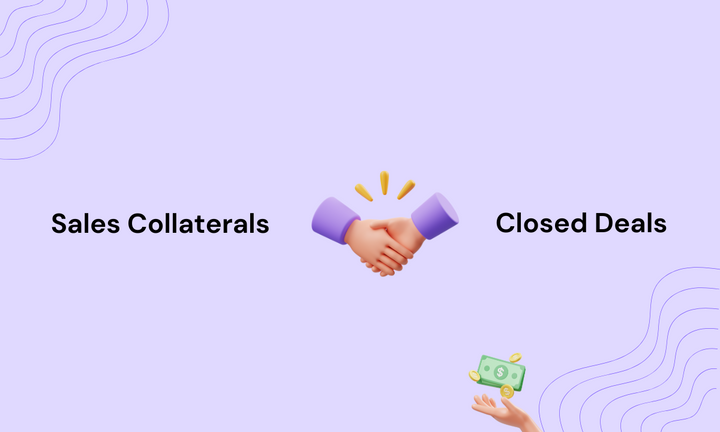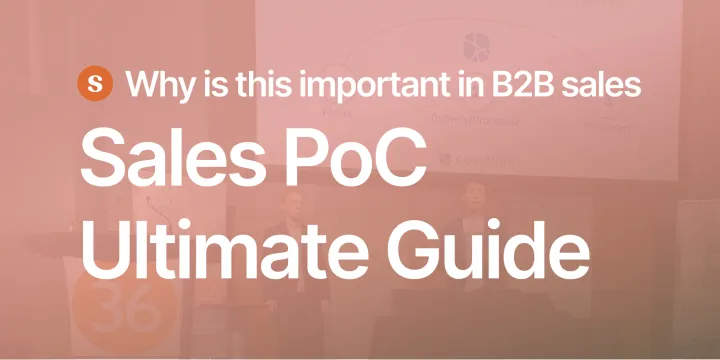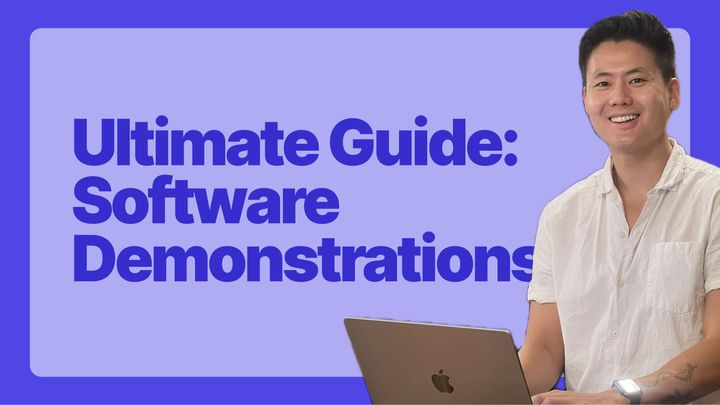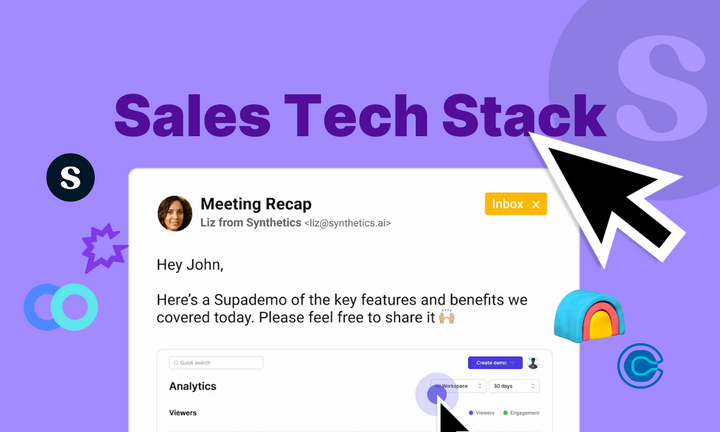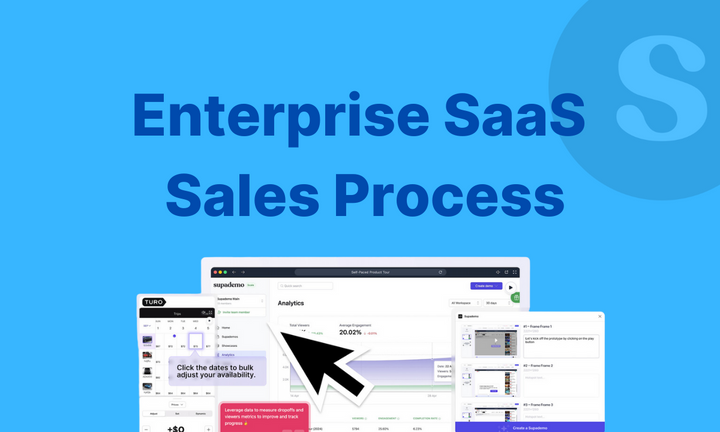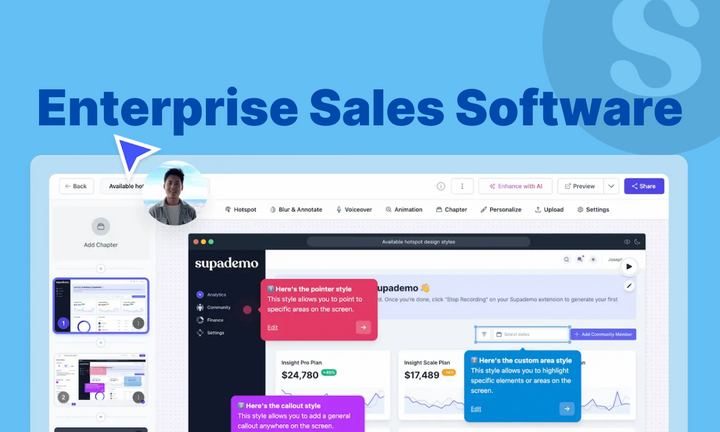A study reveals that the average conversion rate across different sales industries is approximately 47%. However, win rates in the SaaS industry is significantly lower, hovering around 22%.

Today, customers are bombarded with hundreds of marketing messages daily, the right sales collateral can be the difference between blending into the background and standing out as a must-have solution.
A great sales collateral is usually what makes this difference.
What is a Sales Collateral?
These sales enablement resources help explain a product or service, demonstrate its value, and persuade potential customers to make a purchase. Sales collateral acts as a powerful communication tool that bridges the gap between a company's offerings and a customer's needs.
Who Creates Sales Collaterals?
Traditionally, sales collaterals are handled by the product marketing team. However, more often than not sales collateral is typically a collaborative effort involving multiple departments:
- Marketing teams are the primary creators, developing materials that align with the brand's messaging and visual identity.
- Product teams contribute technical details and specific product information to ensure accuracy.
- Sales teams often provide input on what content would be most effective in real-world selling scenarios, helping to shape collateral that resonates with potential customers.
- Design professionals work to make these materials visually appealing and easy to understand.
The goal is to create compelling, informative materials that support the sales process and help convert leads into customers.
Types of Sales Collaterals
Sales collateral has evolved far beyond static PDFs and traditional brochures. Today's content is dynamic, engaging, and tailored to specific stages of the buyer's journey.
Effective sales collateral isn't one-size-fits-all. Instead, it's strategically designed to address prospects' needs at different stages:

| Stage | Goal | Psychology | Collateral Types |
|---|---|---|---|
| Awareness Stage | Introduce your brand and capture attention | Create curiosity and provide value; content should be light, engaging, and solve a surface-level challenge | • Blog posts • Infographics • Social media content • Educational videos • Podcast episodes |
| Consideration Stage | Demonstrate expertise and build trust | Build confidence and show deep understanding of challenges | • Whitepapers • Webinars • Comparison guides • Case studies • Expert reports |
| Decision Stage | Provide concrete proof and facilitate purchase | Reduce risk and provide clear, tangible evidence of value | • Product demos • Customer testimonials • Detailed pricing sheets • Implementation guides • ROI calculators |
Awareness Stage
Goal: Introduce your brand and capture attention
In this stage, prospects are experiencing a problem but might not know the solution. Your collateral should focus on education, not selling.
The psychology here is about creating curiosity and providing value. Content should be light, engaging, and solve a surface-level challenge.
Collateral types for this stage include:
- Blog posts
- Infographics
- Social media content
- Educational videos
- Podcast episodes
Consideration Stage
Goal: Demonstrate expertise and build trust
Prospects now understand their problem and are actively researching solutions. Your collateral should position your brand as a credible, knowledgeable partner. The psychology shifts to building confidence and showing deep understanding of their challenges.
Collateral types for this stage include:
- Whitepapers
- Webinars
- Comparison guides
- Case studies
- Expert reports
Decision Stage
Goal: Provide concrete proof and facilitate purchase
Prospects are close to buying but need final reassurance.
Your collateral must remove all remaining doubts and make choosing your solution feel like the safest, most logical decision. The psychology here is about reducing risk and providing clear, tangible evidence of value.
Collateral types for this stage include:
- Product demos
- Customer testimonials
- Detailed pricing sheets
- Implementation guides
- ROI calculators
The key is understanding your prospect's specific journey and providing precisely the right content at the right moment. A startup founder will need different collateral compared to an enterprise procurement manager.
By mapping collateral to each buyer journey stage, you transform these materials from generic documents to strategic conversion tools.
13 Sales Collateral Examples For Different Stages In The Buyer Journey
Sales collateral is not a one-size-fits-all solution, but a strategic approach to guiding potential customers through their purchasing journey. Each piece of content should be carefully crafted to address specific customer needs, challenges, and mindsets at different stages of their decision-making process.
By understanding and mapping collateral to the awareness, consideration, and decision stages, businesses can create a compelling narrative that transforms prospects into confident buyers.
| Type of Collateral | Stage | Key Characteristics |
|---|---|---|
| Blog Posts | Awareness |
- Address customer pain points - Demonstrate thought leadership - Provide actionable insights - Easily shareable - Non-aggressive introduction |
| eBooks and Guides | Awareness |
- Detailed topic exploration - Downloadable and shareable - Low-commitment engagement - Actionable insights - Professional presentation |
| Social Media | Awareness |
- Authentic, educational content - Demonstrates industry expertise - Builds brand awareness - Encourages organic engagement - Low-pressure relationship building |
| Website Landing Pages | Awareness |
- Problem-specific focus - Clear value proposition - Trackable user engagement - Conversion-oriented design |
| Case Studies | Consideration/Decision |
- Structured storytelling - Quantifiable results - Detailed problem-solution framework - Credibility-building content - Concrete performance metrics |
| Battle-Cards | Consideration |
- Concise competitive analysis - Objective competitor comparison - Market positioning insights - Regularly updated information |
| Sales Call Scripts | All Stages |
- Structured conversation framework - Customizable for pipeline stages - Provides flow guidance - Builds prospect connections |
| Interactive Product Demos | All Stages |
- Guided user experience - Persona-specific demonstrations - Step-by-step feature exploration - Visual storytelling |
| Sales Videos | All Stages |
- Human-centric communication - Personalized messaging - Versatile format - Attention-grabbing - Stage-specific variations |
| Email Templates | All Stages |
- Customizable messaging - Time-saving communication - Stage-reflective designs - Clear call-to-actions - Consistent brand voice |
| Sales Presentations | Consideration/Decision |
- Audio-visual storytelling - Real-time engagement - Problem-solution framework - Interactive and personalized |
| Customer Testimonials | Consideration/Decision |
- Authentic third-party validation - Video testimonials - Written reviews - Success stories - Trust-building across multiple channels |
| Pricing Guides/Calculators | Consideration/Decision |
- Demystifies pricing options - Self-qualification tools - Reduces friction in decision-making - Builds trust through cost transparency |
1. Blog posts (awareness stage)
71% of B2B researchers start with a generic search, rather than looking for a particular brand.
Blog posts are powerful awareness-stage sales collateral that educate potential customers while subtly introducing your brand's expertise.
Key Characteristics
- Address customer pain points
- Demonstrate thought leadership
- Provide actionable insights
- Easily shareable
- Non-aggressive introduction to your solution
HubSpot Example
Consider this blog post on customer data by HubSpot. The guide demonstrates the above-mentioned points perfectly:
👍🏻 Offers practical advice
👍🏻 Softly positions HubSpot CRM as a potential solution
👍🏻 Prioritizes reader value over direct selling
An effective blog post makes readers think, "These people understand my problems."
2. eBooks and guides
eBooks and guides are comprehensive resources that provide deep insights into industry challenges while offering valuable, shareable content.
Key Characteristics
- Detailed topic exploration
- Downloadable and easily distributed
- Low-commitment engagement
- Actionable insights
- Professional presentation
ClickUp Example

Consider this playbook on website funnel fix by ClickUp. It:
👍🏻 Provides actionable strategies
👍🏻 Includes downloadable templates
👍🏻 Offers industry benchmark statistics and anecdotes
👍🏻 Concludes with optional live demo invitation
An effective eBook makes readers think, "These experts truly understand my business needs."
3. Social media (awareness stage)
Social selling is about providing valuable content that resonates with your target audience, not aggressive direct messaging.
Key Characteristics
- Authentic, educational content
- Platform for demonstrating industry expertise
- Builds brand awareness
- Encourages organic engagement
- Low-pressure relationship building
And social media needn't just be limited to your company's offical page. Employees at a company can use their accounts too - in fact personal accounts fare better than company profiles.
Equals Example: Matt Hodges' LinkedIn Strategy

Let's take a look at Matt Hodges, the Head of Product Marketing at Equal's LinkedIn. In his content, he:
👍🏻 Uses personal content as distribution channel for their blog (called Wrap Text)
👍🏻 Builds credibility through transparent storytelling
👍🏻 Shares usecases of Equals in easy-to-digest formats
An effective social media strategy makes followers think, "This person really gets my professional challenges."
4. Website landing pages
Website landing pages are strategic entry points designed to capture and guide potential customer interest through targeted, benefit-focused messaging.
Key Characteristics
- Problem-specific focus
- Clear value proposition
- Trackable user engagement
- Pathway to deeper content
- Conversion-oriented design
ChartMogul Example

Consider this landing page on subscription analytics by ChartMogul. It:
👍🏻 Provides links to additional resources, thus guiding prospects naturally through the sales funnel
👍🏻 Includes compelling social proof
👍🏻 Clear, actionable call-to-action
An effective landing page makes visitors think, "This solution directly solves my specific business challenge."
5. Case studies (consideration/decision stage)
Case studies are powerful, data-driven narratives that showcase your product's real-world problem-solving capabilities.
Key Characteristics
- Structured storytelling
- Quantifiable results
- Detailed problem-solution framework
- Credibility-building content
- Concrete performance metrics
Supademo Example

Let's consider Supademo's case studies. In these case studies, we:
👍🏻 Highlight precise solution implementation
👍🏻 Present measurable impact with clear numbers
👍🏻 Show direct business value
By transforming abstract promises into concrete success stories, case studies bridge the gap between interest and purchase decision.
An effective case study makes prospects think, "This solution works exactly like I need it to work."
6. Battle-cards (consideration stage)
78% of competitive intelligence leaders use battle-cards. Battle-cards are strategic documents that provide sales teams with a comprehensive view of competitive landscape, enabling more informed customer conversations.
Key Characteristics
- Concise competitive analysis
- Objective competitor comparison
- Market positioning insights
- Actionable intelligence
- Regularly updated information
Battle-card best practices

👍🏻 Tier competitors by threat level
👍🏻 Conduct thorough research
👍🏻 Maintain periodic updates
An effective battlecard makes sales representatives think, "I'm fully prepared to address any competitive comparison."
7. Sales call scripts (all stages)
Sales call scripts are strategic conversational guides that help sales representatives navigate customer interactions more effectively and consistently.
Key Characteristics
- Structured conversation framework
- Customizable for different pipeline stages
- Provides conversation flow guidance
- Improves communication consistency
- Helps build prospect connections
Sales call script example
A simple example script for an intro during a sales call could look like:
"Hi [Name], I appreciate you taking the time today. We've got 45 minutes scheduled, and I want to make sure we use this time effectively. Here's what I'm thinking:
- Briefly recap our previous conversation
- Understand your current priorities
- Walk through a targeted demo of our solution
- Discuss how this specifically addresses your [specific business challenge]
Would this approach work for you? I'm particularly interested in hearing your thoughts on [specific pain point]."
You can read more ideas+templates on effective sales demonstration scripts here.
8. Interactive product demos (all stages)
Interactive product demos provide potential customers with immersive, hands-on experiences of your product's capabilities.
Key Characteristics
- Guided user experience
- Persona-specific demonstration
- Step-by-step feature exploration
- Low-commitment engagement
- Visual storytelling
These demos can be in a software demo video format, an HTML clone, or interactive screenshots.
The future of sales demos is interactive demos.
Typically guided by pre-programmed steps, these interactive demos guide users through key features or persona-based benefits for your product – helping visually guide prospects in software demo presentations in a step-by-step, engaging way.
Here’s a brief look into the benefits of interactive demos:
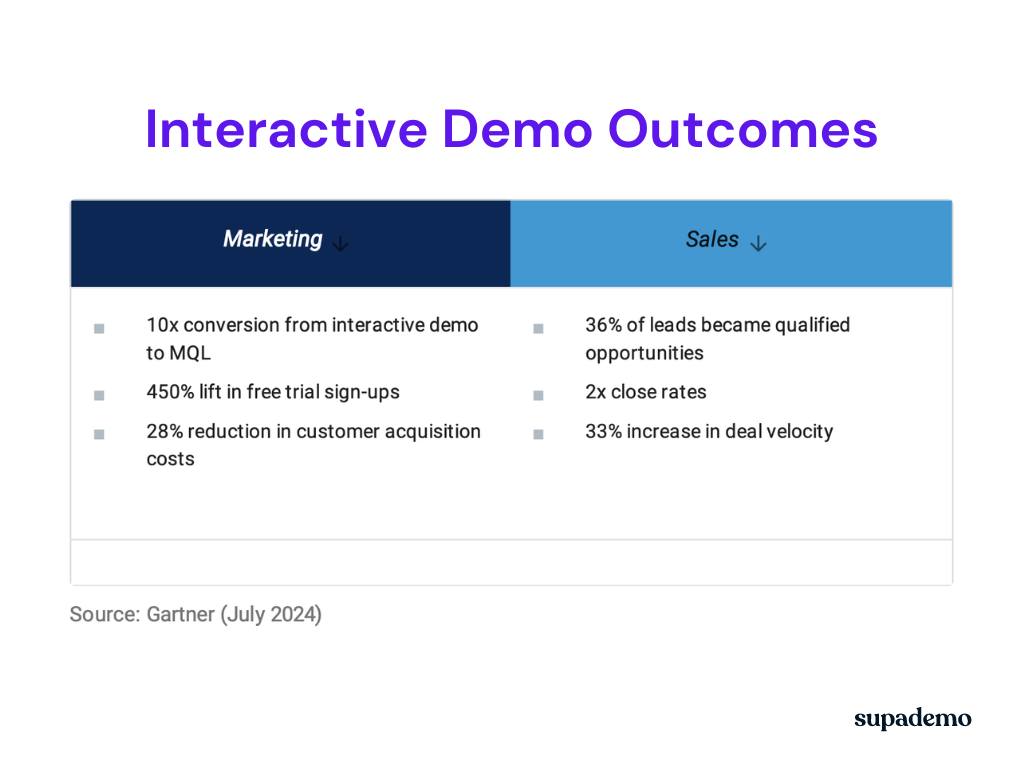
This type of interactive demo is made possible by automatically capturing screens and video steps through an extension using a no-code platform like Supademo.
Here's an example of what an interactive software demo presentation looks like ✨
Supademo also helps create demo sandbox environment using demo automation. These are controlled spaces designed specifically for showcasing your product to potential customers. It’s a separate instance of your product that lets prospects experience your solution instantly, without the friction of signing up or going through a lengthy setup process.
Sounds like you might need a lot of technical assistance from your engineering team? Not really. You just need the right sales tech stack – like Supademo’s native HTML demo recorder:
Case in point – with Supademo, you can quickly clone your product’s frontend (HTML/CSS) with just a few clicks, ensuring a pixel-perfect demo environment that never breaks.
9. Sales videos (all stages)
Sales videos offer a personal, dynamic approach to engaging potential customers through visual storytelling.
Key Characteristics
- Human-centric communication
- Personalized messaging
- Versatile content format
- Attention-grabbing
- Stage-specific variations
Different sales video types
- Pre-meeting introductions
- Team expertise showcases
- Product feature demonstrations
- FAQ explanations
- Customer testimonials
Superflow Example
Here's an example product feature demonstration video by Superflow.
This is a great sales collateral:
👍🏻 Concise and attention-focused
👍🏻 Visually straightforward
👍🏻 Multipurpose (sales and marketing use)
10. Email templates (all stages)
Email templates streamline communication while maintaining a personalized, human touch for sales interactions.
Key Characteristics
- Customizable messaging
- Time-saving communication
- Situation-specific designs
- Consistent brand voice
- Quick adaptation
- Clear call-to-actions
- Reflect prospect's stage in buying journey
Types of sales collateral email templates
- Follow-up communications
- Cold outreach
- Demo invitations
- Feedback requests
- Nurturing leads

An effective email template makes prospects think, "This feels like a personalized message, not a mass email."
11. Sales presentations (consideration/decision stage)
Sales presentations are usually powerful sales collaterals. These are product deck that use strategic storytelling tools that transform product information into compelling narratives.
One can create such collaterals using PowerPoint, Google Slides, Canva, etc.
Key Characteristics
- Audio-visual storytelling
- Real-time customer engagement
- Problem-solution framework
- Interactive communication
- Personalized approach

12. Customer testimonials/video reviews
56% of consumers believe testimonials help them make a decision and 2 out of 3 consumers are more likely to purchase a product after seeing a video testimonial.
Client testimonials are powerful trust-building tools that transform potential customers' uncertainty into confident decision-making. They provide authentic, third-party validation that resonates far more powerfully than any company-generated marketing message.
Supademo's example
We, at Supademo, integrate testimonials across multiple collateral types, creating a comprehensive trust-building ecosystem:
- Video testimonials showcasing specific problem-solving instances
- Written reviews highlighting unique product capabilities

- Customer success stories demonstrating tangible business impact

- Integration of testimonials in product demos, landing pages, and outreach/followup emails, social media content, etc.
13. Pricing guides/calculators (consideration/decision stage)
Some companies offer straightforward, fixed-price models.

While others operate with intricate, multilayered pricing structures that can confuse potential customers.

In these scenarios, a well-designed pricing guide or calculator becomes more than just a feature—it's a critical communication tool that helps demystify investment options and support informed decision-making.
They empower prospects to explore different scenarios, understand value propositions, and self-qualify without the need for extensive sales interactions. These tools not only reduce friction in the sales process but also build trust by providing immediate, personalized cost visibility.
However, pricing guides aren't universally necessary. Simple, low-cost consumer products or services with standard pricing tiers might find them superfluous. The key is recognizing when such a tool adds value—typically for high-investment services, products with variable cost components, or solutions requiring significant customization.
Some organizations even develop internal pricing calculators to streamline their sales processes, enabling sales teams to generate accurate quotes quickly and efficiently.
Optimizing Sales Collateral: Best Practices + Tips
Effective sales collateral transforms complex information into a compelling journey that guides prospects toward confident decision-making. Here's how you can achieve this easily.
| Aspect | Key Actions |
|---|---|
| Audience Understanding | - Design collateral for specific customer personas - Map content to buyer journey stages - Identify pain points for each segment - Create tailored, resonant content |
| Value-Driven Content | - Focus on business outcomes, not just features - Use tangible language addressing real-world problems - Share compelling success stories - Highlight ROI and benefits |
| Design and Engagement | - Use visually appealing designs - Ensure mobile-responsiveness - Incorporate diverse media: infographics, videos, interactive elements - Balance text with visuals |
| Brand Consistency | - Maintain a uniform voice - Align with brand guidelines - Create a cohesive narrative reflecting brand personality - Ensure instant brand recognition |
| Strategic Optimization | - Track engagement metrics - Measure conversion rates - Gather feedback from sales teams and customers - Regularly update content |
| Technical Considerations | - Optimize for multiple platforms and devices - Ensure shareability and accessibility - Include clear calls-to-action - Make content easy to download/distribute |
| Continuous Improvement | - Conduct performance audits - Stay updated with market trends - Test new content formats - Adapt to evolving customer needs |
The Future of Sales Collateral is Interactive Demos
Modern sales collateral is about more than just presenting information—it's about creating immersive experiences that speak directly to a prospect's unique challenges and needs.
Interactive product demo's ability to rapidly create, customize, and deploy interactive demos, personalized content, and engaging storytelling will separate industry leaders from followers.
In newer and more complex B2B selling, sales collateral is not just a supporting tool—it's a critical strategic asset that can significantly accelerate the sales process and drive meaningful business growth.
Using Supademo, anyone can create replicas of products for live demos, sales, products tours and more – all in just a few minutes with no code required.

Just use our Chrome extension or desktop app to quickly record your intended product demo. Supademo instantly generates a true-to-life HTML-based interactive demo that allows for extensive post-recording customization, including:
• Usage and integration of dynamic variables to update content within the interactive demo;
• Blurring and hiding of sensitive data and/or divs;
• Swapping logos, names, media, and content within the recorded product demo in a one-off or dynamic basis;


